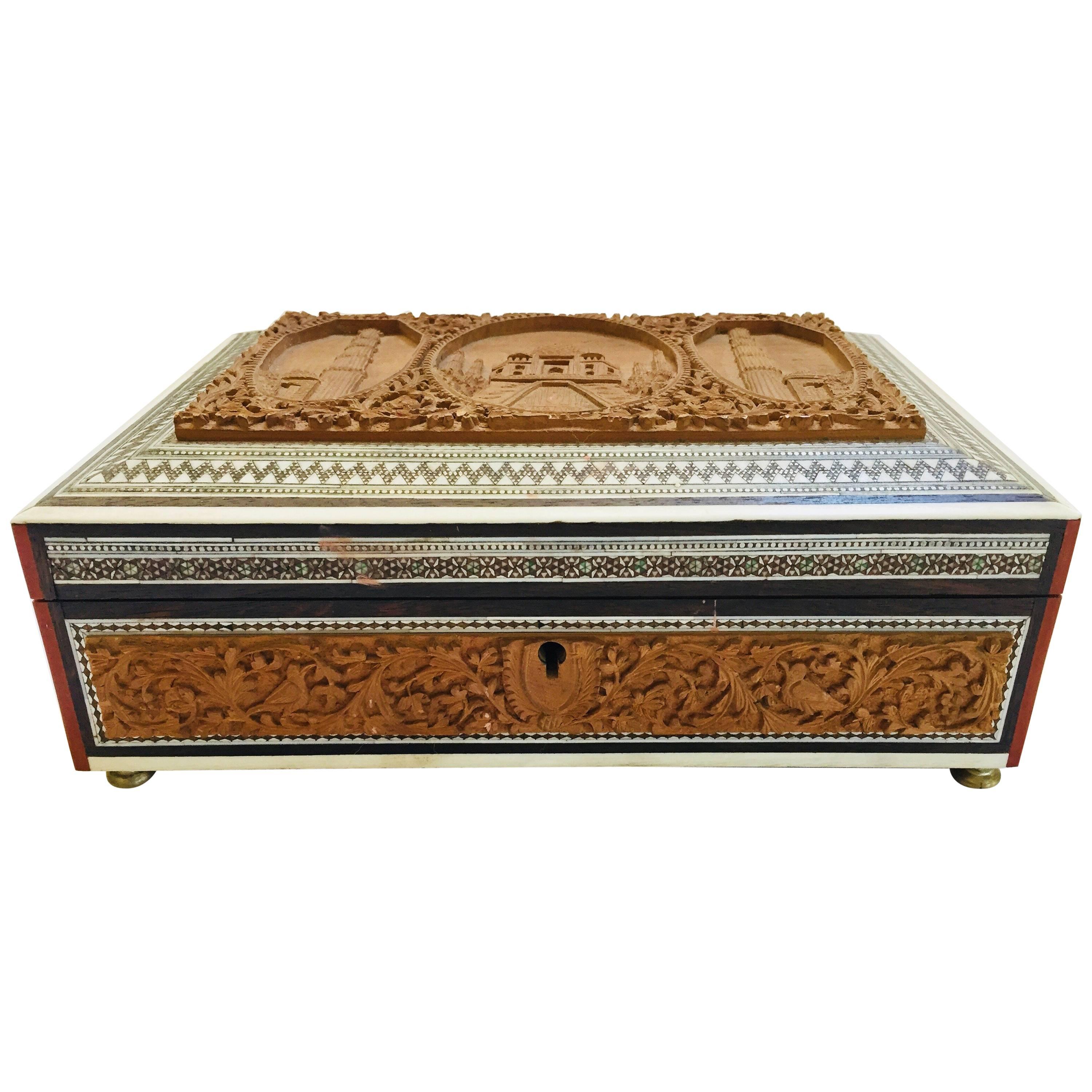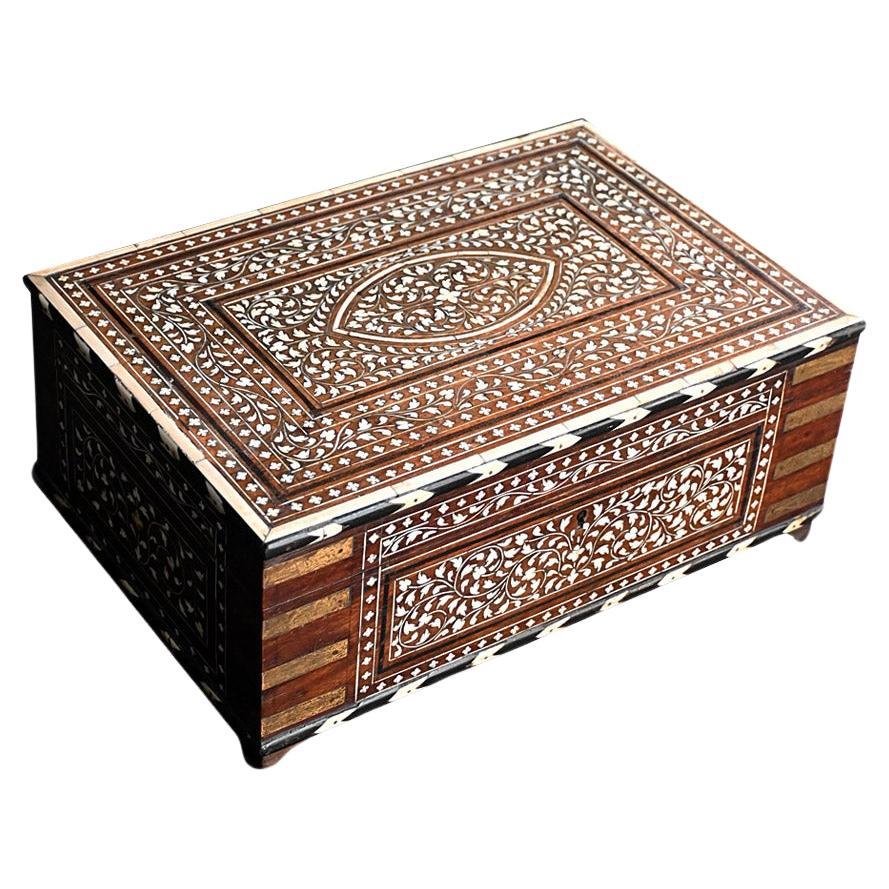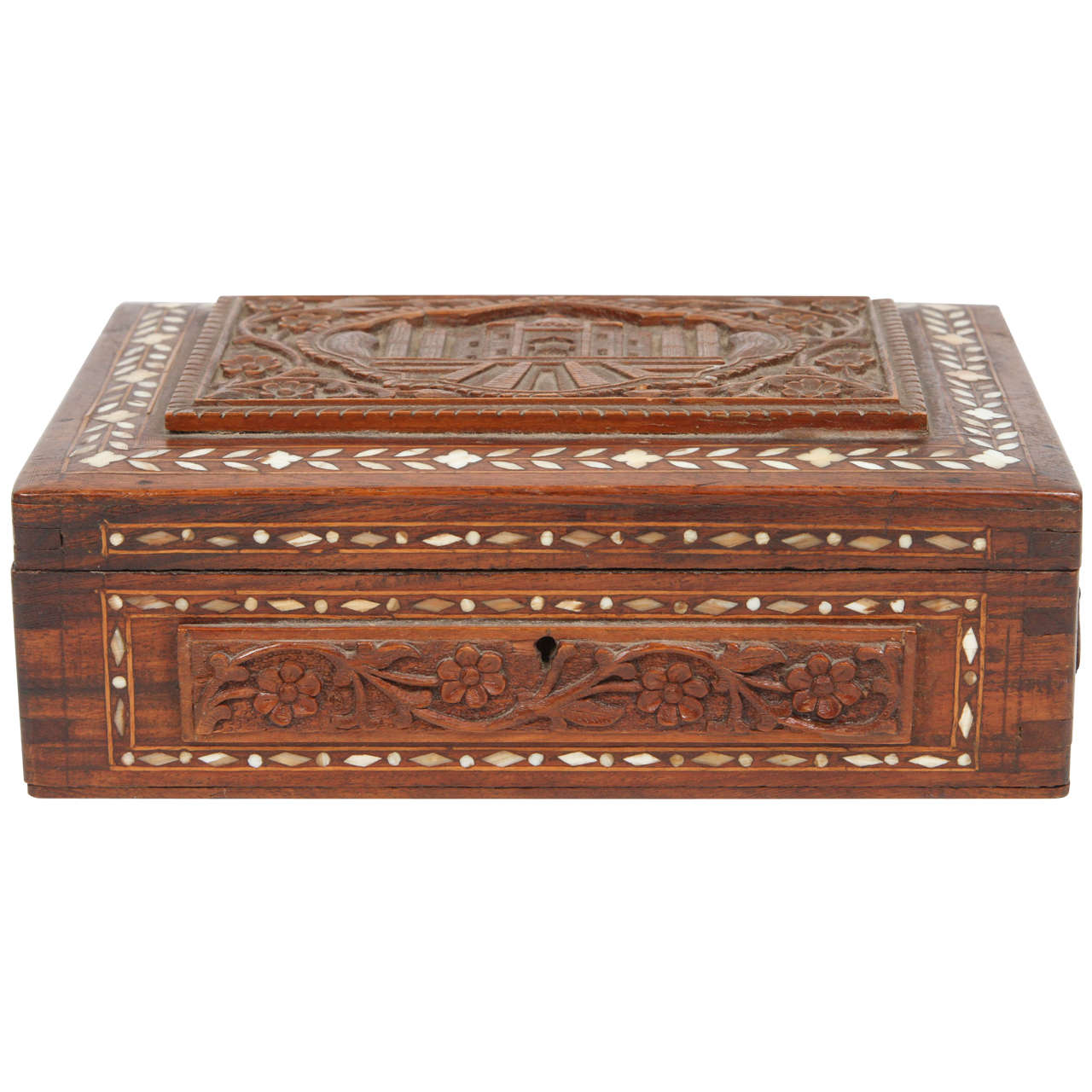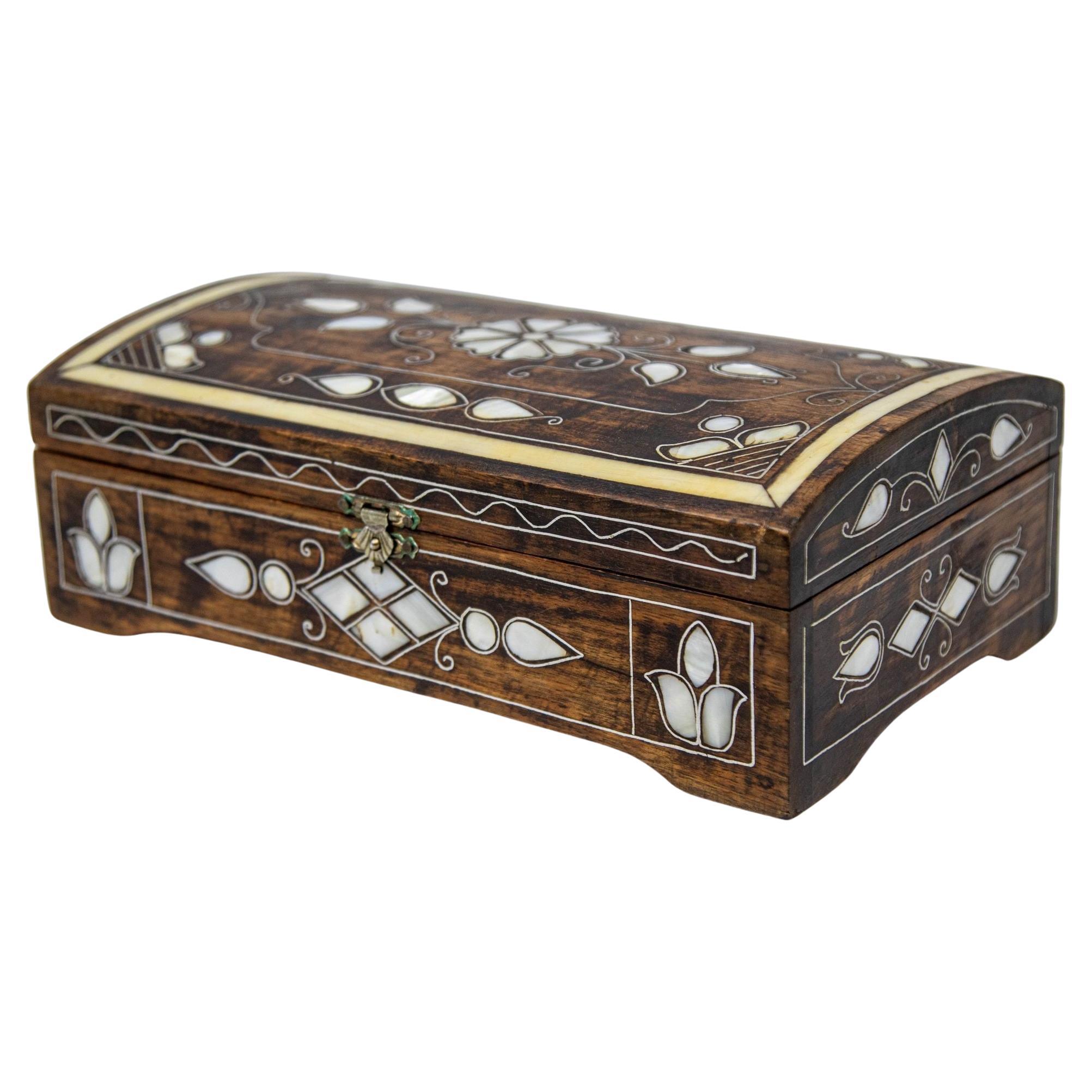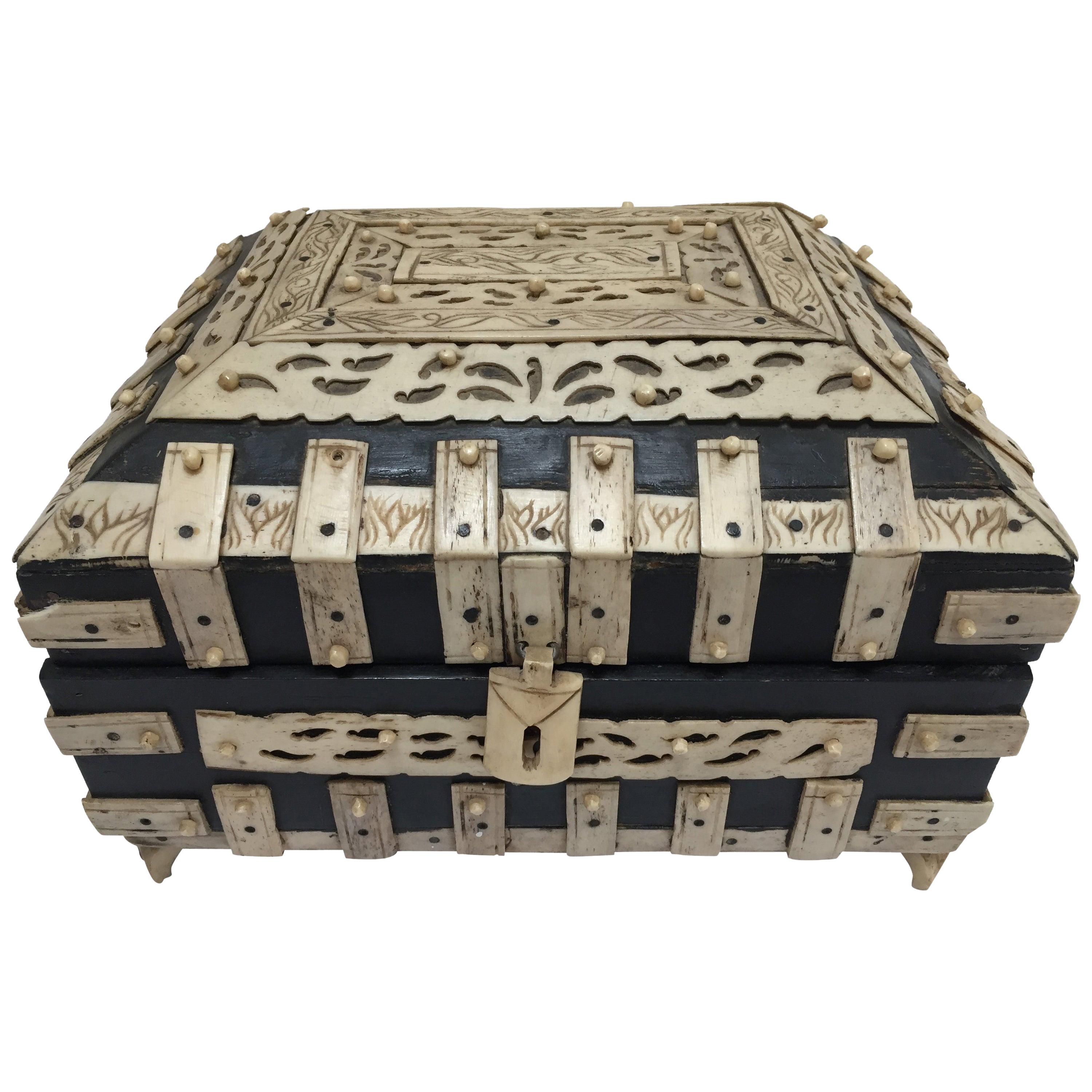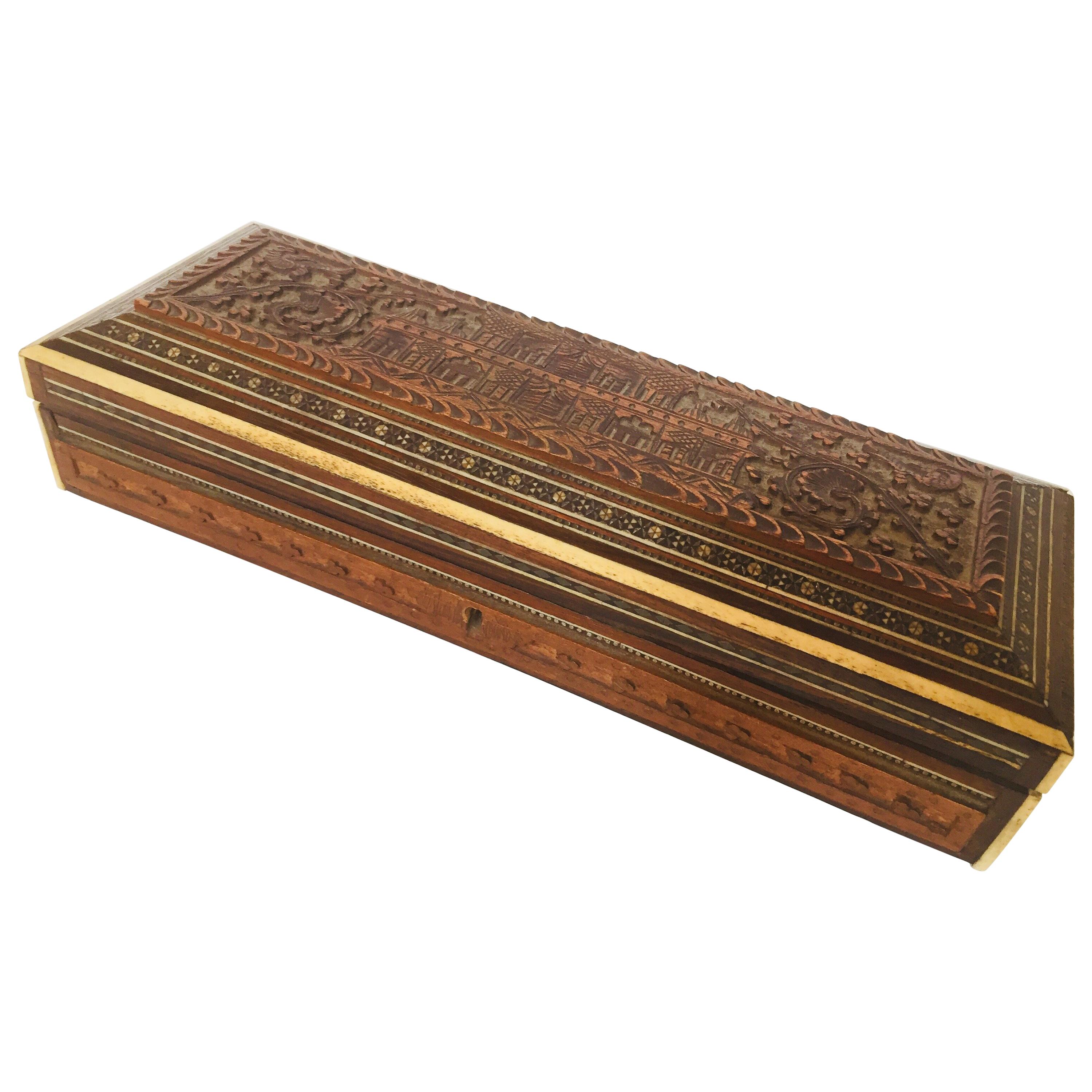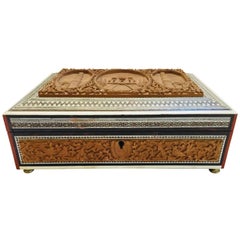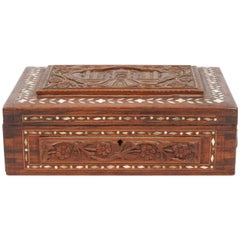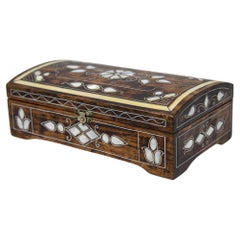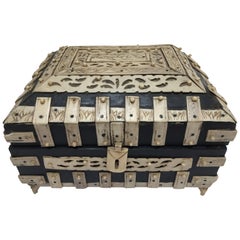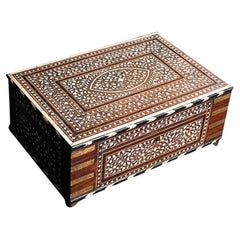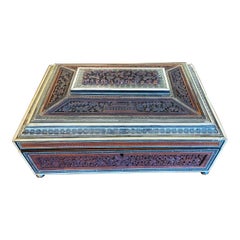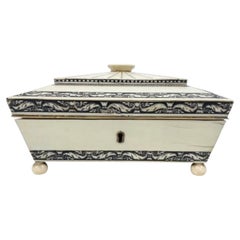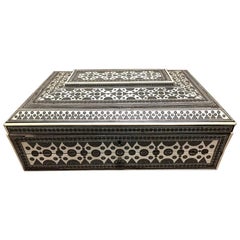Items Similar to Antique Anglo-Indian Vizagapatam Jewelry Inlaid Sadeli Footed Box
Video Loading
Want more images or videos?
Request additional images or videos from the seller
1 of 20
Antique Anglo-Indian Vizagapatam Jewelry Inlaid Sadeli Footed Box
$1,950
£1,481.07
€1,711.13
CA$2,733
A$3,058.74
CHF 1,596.43
MX$37,300.81
NOK 20,432.07
SEK 19,341.57
DKK 12,769.93
Shipping
Retrieving quote...The 1stDibs Promise:
Authenticity Guarantee,
Money-Back Guarantee,
24-Hour Cancellation
About the Item
Antique 19th century Anglo-Indian jewelry, trinket footed box, inlay with ebony, mosaic marquetry Sadeli work and a carved Hindu scene on top.
The box case is made from sandalwood with highly hand-carved padouk wood reliefs on all sides and banded and edged in fabulous Sadeli Mosaic, made from bone, ebony, in various geometric patterns.
The carving lid and sides of this box is fabulous!
The ancient art of Sadeli Mosaic is said to have been introduced from Shiraz in Persia via Sind to Bombay, a long time before the Anglo Indian boxes were made.
The workmanship was however more than commensurable to the value of the materials.
Hand carved on the top with a scene of Vishnu in the center and 2 Indian ladies worshiper on each side making offering.
The box is finely hand carved on top and on each side and inlay with mosaic marquetry in shell and bone.
The sides and rear have highly carved foliage relief panels. The lid opens to reveal the original blue velvet lining (also on the base).It has its key but not working lock. It sits on it’s four original brass turned ball feet.
Anglo-Indian Vizagapatam box. Circa 1880-1890.
DIMENSIONS: Height: 3.25 in Width: 9 in Depth: 6.5 in.
History of the Anglo-Indian Boxes:
Beginning in the early part of the 18th century, Indian artisans made what came to be known as Anglo-Indian boxes for the English residents living in India, who eventually brought or sent them back to England.
At the beginning of the 19th century, India began exporting these boxes commercially, although not in any significant numbers until the 1850s.
People valued them so highly that manufacturers of tins copied the designs on them in the late 19th and early 20th century.
Carved boxes often combined with Sadeli mosaic.
The first two categories came from Vizagapatam in East India while the last two came from Bombay in West India.
English traders discovered the rich woods and intricate workmanship of Indian artisans, so colonial government officials began to recognize the work of the Indian artists and craftsmen as a source for satisfying the need for furniture and boxes, which would both serve to enhance English households in India.
This gave rise to the cabinetmaking workshops in Vizagapatam between Calcutta and Madras.
Craftsmen made the first boxes to be decorated with Sadeli mosaic incised to give further definition to the decoration, directly inlaid into the wood.
The shape of the early boxes was either sloping at the front with a flatter section at the back, reminiscent of English writing slopes, or rectangular.
Artisans inlaid the borders with stylized floral scrolls and the centers with a single floral motif following a circular or oval symmetrical or asymmetrical pattern.
About Vishnu:
Vishnu is one of the principal deities in Hinduism. He is often considered one of the Trimurti, which consists of the three main gods in Hinduism: Brahma, Vishnu, and Shiva. Vishnu is known as the Preserver or Sustainer of the universe, and his role is to maintain cosmic order (dharma) and protect the world from various threats and challenges.
Vishnu is typically depicted as a blue-skinned deity with four arms, holding various symbols and weapons. He is often shown resting on the serpent Shesha (Adi Shesha) in the cosmic ocean. Vishnu is associated with qualities such as compassion, mercy, and benevolence, and he is believed to incarnate on Earth whenever there is a decline in dharma (righteousness) and a rise in adharma (unrighteousness) to restore balance and order. These incarnations are known as avatars, with the most famous being Rama and Krishna.
Devotees of Vishnu worship him in various forms and aspects, and he is a central figure in many Hindu religious texts, including the Vedas, the Mahabharata, and the Bhagavad Gita. Vishnu's consort is the goddess Lakshmi, who represents wealth and prosperity, and they are often worshipped together. Vishnu is also associated with several other deities and forms, such as Narayana and Vasudeva, among others, depending on the specific tradition and beliefs within Hinduism.
The ancient art of Sadeli Mosaic is said to have been introduced from Shiraz in Persia via Sind to Bombay, a long time before the Anglo Indian boxes were made. It was a technique, which required a high degree of skill and patience. It was executed very lavishly, in that the frequent cuts wasted a great amount of the precious materials used. The workmanship was however more than commensurable to the value of the materials.
- Dimensions:Height: 3.25 in (8.26 cm)Width: 9 in (22.86 cm)Depth: 6.5 in (16.51 cm)
- Style:Anglo-Indian (In the Style Of)
- Materials and Techniques:
- Place of Origin:
- Period:
- Date of Manufacture:1880
- Condition:good antique.
- Seller Location:North Hollywood, CA
- Reference Number:Seller: BXR9231stDibs: LU906836283312
About the Seller
5.0
Platinum Seller
Premium sellers with a 4.7+ rating and 24-hour response times
1stDibs seller since 2011
3,048 sales on 1stDibs
Typical response time: 1 hour
- ShippingRetrieving quote...Shipping from: North Hollywood, CA
- Return Policy
Authenticity Guarantee
In the unlikely event there’s an issue with an item’s authenticity, contact us within 1 year for a full refund. DetailsMoney-Back Guarantee
If your item is not as described, is damaged in transit, or does not arrive, contact us within 7 days for a full refund. Details24-Hour Cancellation
You have a 24-hour grace period in which to reconsider your purchase, with no questions asked.Vetted Professional Sellers
Our world-class sellers must adhere to strict standards for service and quality, maintaining the integrity of our listings.Price-Match Guarantee
If you find that a seller listed the same item for a lower price elsewhere, we’ll match it.Trusted Global Delivery
Our best-in-class carrier network provides specialized shipping options worldwide, including custom delivery.More From This Seller
View All19th Century Anglo-Indian Sadeli Mosaic Jewelry Box with Lidded Compartments
Located in North Hollywood, CA
19th century Anglo-Indian sandal wood box, Sadeli mosaic box fitted with various compartments finely hand-carved with the Taj Mahal.
Of sarcophagus form ...
Category
Antique Late 19th Century Indian Anglo-Indian Decorative Boxes
Materials
Sandalwood
19th Century Anglo-Indian Mughal Box
Located in North Hollywood, CA
19th century Anglo-Indian Mughal wood box, inlaid and hand carved with the Taj Mahal and some flowers all around.
Jewelry box, Anglo-Raj box from India in great condition.
Nice Mughal Bombay Box...
Category
Antique Late 19th Century Indian Anglo Raj Decorative Boxes
Materials
Sandalwood
Anglo-Indian Mother of Pearl Inlaid Jewelry Box
Located in North Hollywood, CA
Anglo-Indian Mother of Pearl Inlaid jewelry Box.
1940s Victorian Anglo Indian box in silver, bone and mother of pearl Inlaid.
An elegant Anglo Indian bon...
Category
Mid-20th Century Indian Anglo-Indian Decorative Boxes
Materials
Wood
Anglo-Indian Vizagapatam Bombay Mughal Style Footed Box With Bone Overlay
Located in North Hollywood, CA
Nice and unusual Indian Mughal style large decorative box, filigree and carved horn.
Anglo-Indian footed domed box with exceptional engraved details throughout with filigree and carved veneered bone plaques with arabesque carving.
Vizagapatam, late 19th century.
History of the Anglo-Indian Boxes
Beginning in the early part of the 18th century, Indian artisans made what came to be known as Anglo-Indian boxes for the English residents living in India, who eventually brought or sent them back to England. At the beginning of the 19th century, India began exporting these boxes commercially, although not in any significant numbers until the 1850s. People valued them so highly that manufacturers of tins copied the designs on them in the late 19th and early 20th century.
Anglo-Indian boxes fall into four groups: Rosewood or ebony boxes inlaid;
sandalwood boxes veneered; sandalwood boxes covered with Sadeli mosaic; and carved boxes often combined with Sadeli mosaic/
The first two categories came from Vizagapatam in East India while the last two came from Bombay in West India.
English traders discovered the rich woods and intricate workmanship of Indian artisans, so colonial government officials began to recognize the work of the Indian artists and craftsmen as a source for satisfying the need for furniture and boxes, which would both serve to enhance English households in India. This gave rise to the cabinetmaking workshops in Vizagapatam between Calcutta and Madras.
Craftsmen made the first boxes to be decorated with Sadeli mosaic of rosewood or ebony, incised to give further definition to the decoration, directly inlaid into the wood. The shape of the early boxes was either sloping at the front with a flatter section at the back, reminiscent of English writing slopes, or rectangular. Artisans inlaid the borders with stylized floral scrolls and the centers with a single floral motif following a circular or oval symmetrical or asymmetrical pattern. The edging was ornamental and protective, both helped protect the end grain against the weather.
Made in Vizagapatam, situated on the south east coast of India, near Madras
These exotic boxes...
Category
Antique Late 19th Century Indian Anglo Raj Decorative Boxes
Materials
Wood
Fine Antique Anglo Indian Bombay Inlay Box
By Rajhastani
Located in North Hollywood, CA
Fine antique Anglo-Indian hand carved wooden jewelry box inlaid.
Nice Indian Mughal pen box handcrafted in very fine Sadeli micro mosaic...
Category
Antique Late 19th Century Indian Islamic Decorative Boxes
Materials
Wood
Anglo Indian Colonial Brass Inlaid Teak Jewelry Box
Located in North Hollywood, CA
A Beautiful Anglo Indian, Colonial, brass inlaid teak jewelry lidded box made for the English market.
handcrafted with floral and hearts brass inlays on top are surrounded by brass inlaid border, intricate brass inlays design of florals and scrolls carries through to all four sides so will display nicely on a shelf, desk or coffee table.
Displays a desirable aged patina and the teak wood shows fine grain interest and deep caramel hues.
A large Anglo-Indian teak colonial Campaign casket with brass inlay, the hinged cover opens to reveal an original fitted interior with two compartments interior lined with red velvet.
This is a distinctive and highly appealing vintage semi antique Anglo Indian jewelry...
Category
Mid-20th Century Indian Anglo-Indian Decorative Boxes
Materials
Brass
You May Also Like
19th Century Hoshiarpur Inlaid Writing Box
Located in London, GB
19th Century Hoshiarpur Inlaid Writing Box
Quite simply, this is a stunning example of a 19th Century hand crafted Hoshiarpur inlaid writing box. The craftsmanship is quite amazing ...
Category
Antique 1870s Indian Early Victorian Decorative Boxes
Materials
Wood
19C Anglo Indian Highly Carved Teak Sadeli Mosaic Inlaid Sewing Box
Located in Dallas, TX
PRESENTING A LOVELY 19C Anglo Indian Highly Carved Sadeli Mosaic Inlaid Sewing Box.
Made in Bombay, India, circa 1880.
The box is made of sandalwood with highly carved raised teak wood panels on all sides, depicting temple scenes, animals and foliage.
The box is in a sarcophagus form.
It is edged in bone (and we can tell it is bone and not ivory, from the color and evidence of capillaries, which are not found in ivory), and banded with Bombay Sadeli mosaic and ebony veneer.
The lid opens to reveal a removable tray with various open compartments and lidded compartments. 5 lidded compartments, 1 unlidded compartment and 8 holders for thimbles, etc
The tray lifts to reveal a blue velvet (original) lined section, for storing jewelry etc, with sections for collars etc.
The inside of the lid has a removable mirror (the mirror is missing on this one but can easily be replaced). Behind the mirror is the original green velvet lining.
It has its original brass carry handles on the sides and sits on 4 silvered button feet (of recent origin).
Some repairs to the exterior and condition issues (priced accordingly), but still a LOVELY COLLECTIBLE box!
These boxes were made by superb Indian craftsmen, specifically for sale to the ruling British elite. These types of boxes, carved padouk and sandalwood, (whilst beautiful and superbly crafted) were of a lesser quality, than the more profusely and intricately mosaic inlay, tortoiseshell and ivory boxes, made for the British ‘Upper Classes’ in the areas of Bombay and Vizagapatam. These type of boxes were much more affordable back in 1880 (and indeed today) and would probably have been bought by mid-level diplomats, civil servants or visitors.
Sewing boxes (in general), were in EVERY Victorian home in Britain in the 19th century and like other boxes etc were ‘status symbols’ of your place in society! The more ornate the box, the more ‘Upper Class’ you were!
SADELI MOSAIC: “Anglo Indian boxes were made in India for the English residents from the early part of the 18th century. They were brought back or sent back to England usually by the people who had commissioned them. From the beginning of the nineteenth century they were imported more commercially, although not in any significant numbers until the middle decades. They were very highly valued, especially the early ones, to the extent that the designs were copied on late 19th and early 20th century tins.
The ancient art of Sadeli Mosaic is said to have been introduced from Shiraz in Persia via Sind to Bombay, a long time before the Anglo Indian boxes were made. It was a technique, which required a high degree of skill and patience. It was executed very lavishly, in that the frequent cuts wasted a great amount of the precious materials used. The workmanship was however more than commensurable to the value of the materials.
Ivory, silver, pewter (or other metals), wood and Horn were cut into faceted rods which were bound together to form geometric patterns. When the glue has set, the rods were sliced in transverse sections. This gave the maker a number of angled circular pieces in the original pattern. Several variations of patterns could be achieved by combining the materials in different ways. The ivory was sometimes dyed green to give an extra color.
The mosaic pieces in a combination of patterns, often separated by ivory, ebony, Horn or silver stringing were used to veneer sandalwood boxes. In the early boxes, which date from the turn of the 18th to the 19th century, there are large panels of mosaic covering tops and sides of boxes. It took incredible skill to cover such large areas without any shakes or wavering of the pattern. The corners and joins on these boxes are impeccably matched.
The makers (reputed to be Persian) of Sadeli mosaic made in the first two decades of the 19th century displayed a total understanding of the qualities of the different materials they used. They combined substances, which can expand and contract according to atmospheric conditions with others, which are hard and unyielding. The result was a sharp definition of the lines and patterns, which made up the whole design.
On the early boxes the designs look deceptively simple. The fact is, they emerged from a culture, which had mastered geometry and understood how to generate a pattern from a set number of points. The patterns are so harmoniously combined that their incredible complexity is not immediately apparent.
The earliest Sadeli boxes...
Category
Antique Late 19th Century Indian Anglo-Indian Decorative Boxes
Materials
Bone, Sandalwood, Teak
Veneered Footed Sandalwood Sewing Box w/Penwork Decoration, Vizagapatam, India
Located in Chapel Hill, NC
Anglo-Indian penwork decorated veneered sandalwood box in the Regency taste, the two-tier sloped lid with a fluted carved upper tier above a smooth lower tier with penwork border and...
Category
Antique Mid-19th Century Indian Anglo-Indian Decorative Boxes
Materials
Metal
19th Century Anglo-Indian Sadeli Inlaid Work Box Traveling Writing Desk
Located in Stamford, CT
A stunning camel bone, ebony and metal inlaid sadeli work box with portable writing desk, Bombay, circa 1850.
The sandalwood body of faceted rec...
Category
Antique Mid-19th Century Indian Anglo-Indian Decorative Boxes
Materials
Metal
19C Anglo Ceylonese Specimen Wood Trinket Box
Located in Dallas, TX
PRESENTING A BEAUTIFUL and RARE 19C Anglo Ceylonese Specimen Wood Trinket Box.
Made in ‘Galle’, Ceylon (now Sri Lanka) circa 1860-80.
Made for the ex...
Category
Antique 19th Century Sri Lankan Anglo-Indian Jewelry Boxes
Materials
Bone, Hardwood, Ebony, Sandalwood
19th Century Anglo Indian Vizagapatam Carved Sandalwood Box Micro Mosaic Inlays
Located in West Sussex, Pulborough
We are delighted to offer for sale this lovely 19th century Anglo-Indian Vizagapatam carved sandalwood and inlaid box
Mid-19th century Anglo-Indian Vizagapatam carved sandalwood box...
Category
Antique 19th Century Indian Anglo-Indian Decorative Boxes
Materials
Wood
$287 Sale Price
30% Off
More Ways To Browse
Indian Jewellery
Floral Jewelry Box
Antique Blue Boxes
Antique Band Box
Inlay Jewellery Boxes
Mother Of Pearl Jewlery Box
Antique Indian Jewelry
Hand Carved Jewellery Box
Oval Antique Jewelry Box
Antique Foot Rest
Box Wood Carving
Indian Inlay
Anglo Indian Jewelry
Indian Inlay Furniture
Serpent Object
Anglo Indian Carved Wood
Inlaid Indian Furniture
Indian Pearl Jewelry
